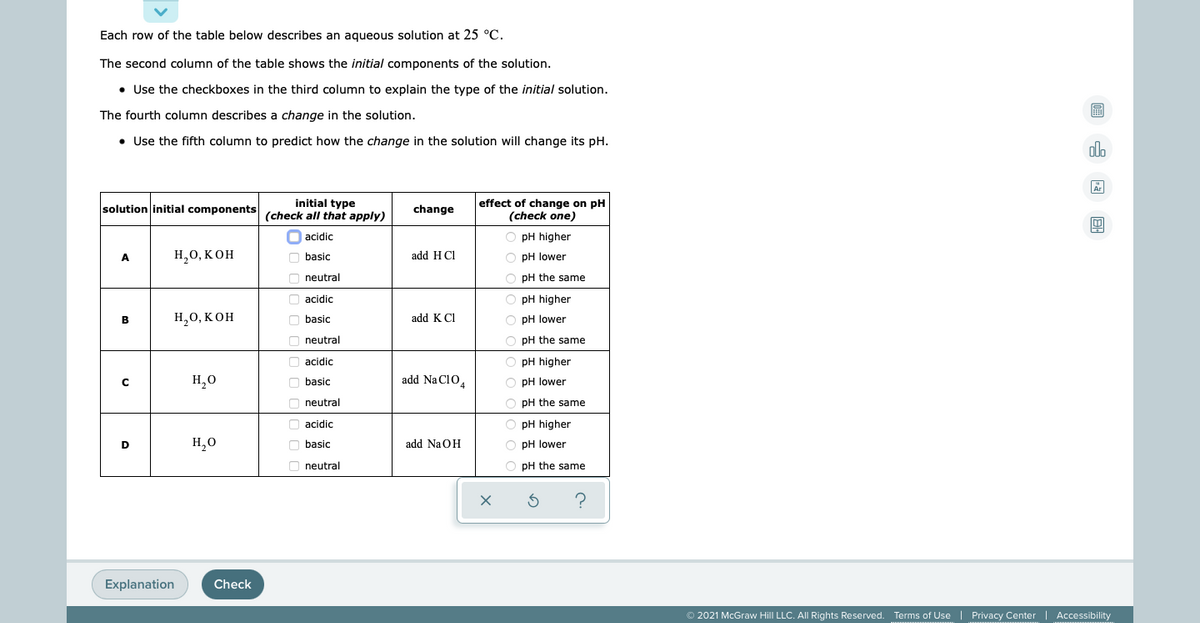Each row of the table below describes an aqueous solution at 25 °C. The second column of the table shows the initial components of the solution. • Use the checkboxes in the third column to explain the type of the initial solution. The fourth column describes a change in the solution. • Use the fifth column to predict how the change in the solution will change its pH. initial type solution initial components (check all that apply) effect of change on pH (check one) change acidic O pH higher н,о, Кон add HCI pH lower A basic O pH the same neutral acidic pH higher н,о, кон basic add K CI pH lower neutral pH the same acidic pH higher H,0 add Na C10, O pH lower basic neutral pH the same acidic pH higher D H,0 basic add NaOH pH lower neutral pH the same ? O o Oo OO O0 0 O
Each row of the table below describes an aqueous solution at 25 °C. The second column of the table shows the initial components of the solution. • Use the checkboxes in the third column to explain the type of the initial solution. The fourth column describes a change in the solution. • Use the fifth column to predict how the change in the solution will change its pH. initial type solution initial components (check all that apply) effect of change on pH (check one) change acidic O pH higher н,о, Кон add HCI pH lower A basic O pH the same neutral acidic pH higher н,о, кон basic add K CI pH lower neutral pH the same acidic pH higher H,0 add Na C10, O pH lower basic neutral pH the same acidic pH higher D H,0 basic add NaOH pH lower neutral pH the same ? O o Oo OO O0 0 O
Chemistry & Chemical Reactivity
9th Edition
ISBN:9781133949640
Author:John C. Kotz, Paul M. Treichel, John Townsend, David Treichel
Publisher:John C. Kotz, Paul M. Treichel, John Townsend, David Treichel
Chapter16: Principles Of Chemical Reactivity: The Chemistry Of Acids And Bases
Section: Chapter Questions
Problem 108GQ
Related questions
Question

Transcribed Image Text:Each row of the table below describes an aqueous solution at 25 °C.
The second column of the table shows the initial components of the solution.
• Use the checkboxes in the third column to explain the type of the initial solution.
The fourth column describes a change in the solution.
• Use the fifth column to predict how the change in the solution will change its pH.
alo
initial type
(check all that apply)
effect of change on pH
(check one)
solution initial components
change
O acidic
pH higher
н,о, Кон
A
basic
add H Cl
pH lower
O neutral
O pH the same
O acidic
O pH higher
В
Н,0, КОН
O basic
add K CI
O pH lower
neutral
O pH the same
O acidic
O pH higher
H,0
O basic
add Na ClO,
O pH lower
O neutral
O pH the same
O acidic
O pH higher
H,0
O basic
add Na OH
O pH lower
O neutral
O pH the same
Explanation
Check
© 2021 McGraw Hill LLC. All Rights Reserved. Terms of Use | Privacy Center
Accessibility
Expert Solution
This question has been solved!
Explore an expertly crafted, step-by-step solution for a thorough understanding of key concepts.
Step by step
Solved in 4 steps with 3 images

Knowledge Booster
Learn more about
Need a deep-dive on the concept behind this application? Look no further. Learn more about this topic, chemistry and related others by exploring similar questions and additional content below.Recommended textbooks for you

Chemistry & Chemical Reactivity
Chemistry
ISBN:
9781133949640
Author:
John C. Kotz, Paul M. Treichel, John Townsend, David Treichel
Publisher:
Cengage Learning

Chemistry & Chemical Reactivity
Chemistry
ISBN:
9781337399074
Author:
John C. Kotz, Paul M. Treichel, John Townsend, David Treichel
Publisher:
Cengage Learning

Chemistry & Chemical Reactivity
Chemistry
ISBN:
9781133949640
Author:
John C. Kotz, Paul M. Treichel, John Townsend, David Treichel
Publisher:
Cengage Learning

Chemistry & Chemical Reactivity
Chemistry
ISBN:
9781337399074
Author:
John C. Kotz, Paul M. Treichel, John Townsend, David Treichel
Publisher:
Cengage Learning